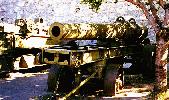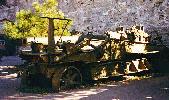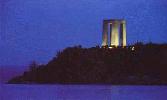| The Dardanelles... |
|
A tremendous amount of world commerce depends on sea travel. Since commerce means wealth and wealth means power, the
people who control the sea have enormous commercial - not to mention military - power. The best place for a small group
of people to control an awful lot of sea is at a strait. The story of the Canakkale Bogazi, or the Dardanelles, is one
of people battling each another for control of this narrow passage which unites the Mediterranean and Aegean seas with
the Marmara and Black seas. In ancient times it was the Achaeans attacking the Trojans: in modern times the Anzacs facing
Ataturk at Gallipoli. The name "Dardanelles" comes from Dardanus, ruler of a very early city-state at Canakkale, who
controlled the straits. The story of the Dardanelles is not all war and commerce; romance. too. has been central to its
mythical associations: legend says that the goddess Helle fell from a golden-winged ram into the water here, giving the
straits the name of Hellespont. The lovesick Leander, separated from his beloved Hero, swam to her through the fierce
currents each night, until one night he didn't make it. "Swimming the Hellespont" is a challenge for amateur and
professional swimmers to this day. The height of romance is the story of two ancient peoples battling over the love and
honour of Helen, the most beautiful Woman in the world. Historians now tell us that Helen was just a pawn in the fierce
commercial and military rivalries between Achaea and Troy. Still, no one says she wasn't beautiful, or that the Trojan
horse didn't actually fool the Trojans and lead to their defeat by the Achaeans. The area of the straits holds these
attractions: the town of Canakkale, a fast-growing agricultural centre on the south-east shore; the fortifications,
ancient and modern, which guarded the straits; the battlefields of Gallipoli on the north-west side ofthe straits; and
the excavated ruins of ancient Troy 32 km to the south. For a week in mid-August, the Canakkale Festival fills the hotels
in town. If you plan to be here around mid-August, arrive early in the day and start your search for a hotel room at once.
You can easily walk to Canakkale's interesting sights. Everything you need is within two blocks of the ferry docks and
the clock tower, except for the otogar and the Archaeological Museum. To get from the otogar to the centre of town near
the clock tower and car-ferry docks, leave the otogar by the front doors, turn left, walk to the first turning to the
right and follow signs straight to the ferryboat. Just before the docks you'll see the vaguely Teutonic clock tower.
|
|

|











